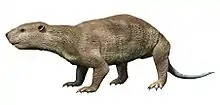Paraborhyaena
Paraborhyaena is an extinct genus of Sparassodont, belonging to the family Proborhyaenidae. It was one of the large terrestrial predators that roamed South America during the Oligocene.[1][2]
| Paraborhyaena Temporal range: Oligocene | |
|---|---|
| Scientific classification | |
| Domain: | Eukaryota |
| Kingdom: | Animalia |
| Phylum: | Chordata |
| Class: | Mammalia |
| Order: | †Sparassodonta |
| Family: | †Proborhyaenidae |
| Genus: | †Paraborhyaena Hoffstetter & Petter, 1983 |
| Species: | †P. boliviana |
| Binomial name | |
| †Paraborhyaena boliviana Hoffstetter & Petter, 1983 | |
Discovery
Fossil remains of Paraborhyaena have been discovered in the Sella Formation in Bolivia. Those fossils date back from 27 to 26 millions of years ago, during the Deseadan stage of the Oligocene.
Description
Paraborhyaena was one of the largest predatory metatherians of all times. It was the size of an American black bear, with a head-torso length of almost 1.5 meters and an estimated weight between 100 and 125 kilograms. Its skull was 40 centimeters long. Paraborhyaena had a robust head with a short snout. Unlike Borhyaena, the large canines of Paraborhyaena kept growing during its life. Its molars were well-suited for tearing flesh. It was a ground-dwelling carnivore, who preyed on medium-sized mammals, such as typotheres.[3]
References
- Paraborhyaena boliviana et Andinogale sallensis, deux marsupiaux (Borhyaenidae) nouveaux du Déséadien (Oligocène inférieur) de Salla (Bolivie). R Hoffstetter & G Petter. Comptes Rendus de l'Académie des Sciences (1983).
- Marsupial skulls from the Deseadan (Late Oligocene) of Bolivia and phylogenetic analysis of the Borhyaenoidea (Marsupialia, Mammalia). C de Muizon. Geobios (1999).
- Horned armadillos and rafting monkeys: the fascinating fossil mammals of South America. DA Croft. Indiana University Press (2016).



